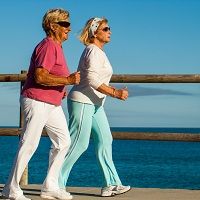Article
Physical Activity Can Improve Cardiovascular Risk Factors As Much As Pharmacotherapy
Author(s):
Individuals who engage in physical activity on a regular basis have improved cardiovascular fitness, improved insulin sensitivity, and improved glucose tolerance.

Though exercise and physical activity are commonly associated with weight loss, they confer a myriad of benefits beyond losing weight. Individuals who engage in physical activity on a regular basis have improved cardiovascular fitness, improved insulin sensitivity, and improved glucose tolerance. William E. Kraus, MD, Professor of Cardiology at Duke University of Medicine, reviewed the body of knowledge on physical activity and its beneficial effects on cardiovascular health at the 2014 Cardiometabolic Health Congress in Boston, MA.
Studies on physical activity dating back to the 1950s have shown that more activity leads to greater benefits in cardiovascular health later in life. Physical fitness is a nontraditional risk factor for developing coronary heart disease (CHD). The more fit a person is on a cardiorespiratory test, the fewer cardiovascular events the person will experience over his or her lifetime. In a study at the Cooper Clinic, patients who engaged in 150 minutes of walking per week had a relative risk reduction of 50% of developing CHD over patients who did not engage in any physical activity. Kraus pointed out that, to date, no pharmaceutical therapy has achieved similar results.
In a series of clinical trials (STRRIDE), Kraus and colleagues have examined the effects of exercise amount and intensity on established cardiovascular risk factors. Participants were between 40-65 years of age, sedentary, having a BMI between 25 and 35 kg/m2, and dyslipidemia. The study randomized participants to engage in one of three exercise regimens (low dose/moderate level; low dose/vigorous level; high dose/vigorous level) or to remain inactive for 6 months. No dietary or pharmacological interventionwas included.
With no physical activity, participants gained 1% of their starting body mass during the 6-month study period. When participants engaged in high dose/vigorous activity, they lost 2% of their starting body mass. Both low dose activity groups saw body mass reductions of approximately 1%. Waist circumference also followed a similar pattern, where inactive participants had an increase, and all three groups of active participants had a decrease, with the high-dose group having the largest decrease.
Vigorous intensity activity reduced total adipose tissue and moderate intensity activity prevented an increase in adipose tissue compared to the inactive group. There was an improvement in insulin sensitivity that was greatest for the low dose/moderate group and the high dose/vigorous group. Triglyceride levels also decreased for all active groups, with the greatest decrease in the low dose/moderate group.
To date, the only established cardiovascular risk factor that Kraus and colleagues have not seen an improvement in when increasing physical activity is levels of C-reactive protein. One caveat is that participants in the study had elevated levels of C-reactive protein at the onset of the study.
It is estimated that adults in the US could add almost 1 year to their average life expectancy by eliminating physical inactivity. Throughout his presentation, Kraus stressed that “prevention is the key” to achieving cardiovascular health.




